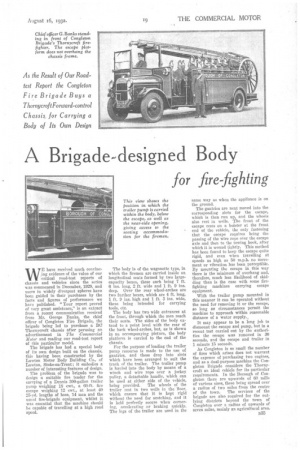A Brigade-designed Body
Page 53

If you've noticed an error in this article please click here to report it so we can fix it.
for fire-fighting
WE have received much couvincing evidence of the value of our critical road-teat reports of chassis and vehicles since the series was commenced in December, 1929, and users in widely divergent spheres have been guided in their purchases by the facts and figures of performance we have published. "Your report proved of very great assistance," is an extract from a recent communication received from Mr. George Banks, the chief officer of Congleton Fire Brigade, the brigade being led to purchase a 130 Thornycroft chassis after perusing an advertisement in The Commercial Motor and reading our road-test report of this particular model.
The brigade has had a special body of its own design built on the chassis, this having been constructed by the Lawton Motor Body Building Co., of Lawton, Stoke-on-Trent; it embodies a number of interesting features of design.
The problem of the brigade was to design a suitable fire tender for the carrying of a Dennis 300-gallon trailer pump weighing 18 cwt., a 60-ft. fire escape weighing 12 cwt., at least 40 25-yd. lengths of hose, 14 men and the usual fire-brigade equipment, whilst it was essential that the machine should be capable of travelling at a high road speed. The body is of the wagonette type, in which the firemen are carried inside on. longitudinal seats formed by two largecapacity boxes, these each being 7 ft. 6 ins. long, 2 ft. wide and 1 ft. 9 ins. deep. Over the rear wheel-arches are two further boxes, which are 4 ft. long, 1 ft. 9 ins, high and 1 ft. 3 ins, wide, these being intended for carrying tools, etc.
The body has two wide entrances at the front, through which the men reach their seats. The sides of the body extend to a point level with the rear of the back wheel-arches, but, as is shown in an accompanying picture, the body platform is carried to the end of the chassis.
For the purpose of loading the trailer pump recourse is made to the use of gantries, and these drop into slots which have been arranged to suit the track of the trailer. The trailer pump is hauled into the body by means of a winch and wire rope over a jockey Pulley, a detachable handle, which can be used at either side of the vehicle,
being provided. The wheels of the trailer rest in two wells in the 'floor, which ensure that it is kept rigid without the need for scotching, and it is held perfectly secure when cornering, accelerating ior braking quickly. The legs of the trailer are used in the same way as when the appliance is on the ground.
The gantries are next moved into the corresponding slots for the escape, which is then run up, and the wheels also rest in wells. The front of the escape rests on a bolster at the front end of the vehicle, the only fastening that the escape requires being the passing of the wire rope over the escape axle and then to the towing hook, after which it is wound tightly. This method has been found to keep the escape quite rigid, and even when travelling at speeds as high as 50 m.p.h. no movement or vibrati-an has been perceptible. By mounting the escape in this way there is the minimum of overhang and, therefore, much less likelihood of skidding than is the case with some firefighting machines carrying escape equipment.
With the trailer pump mounted in this manner it can be operated without the need for removing it or the escape, so long as circumstances permit the machine to approach within reasonable distance of a water supply., It may appear to be a long job to dismount the escape and pump, but in a recent test carried out by the authorities the escape was removed in 30 seconds, and the escape and trailer in 1 minute 15 seconds.
As Congleton is so small the number of fires which arises does not warrant the expense of purchasing two engines, and as a dual-purpose machine the Congleton Brigade considers the Thornycroft an ideal vehicle for its particular requirements. In the Borough of Congleton there are upwards of 60 mills of various sizes, these being spread over a radius of two miles from the centre
of the town. The services of the brigade are also required for the outlying districts beyond the town of Congleton over a radius of upwards of seven miles, mainly an agricultural area.




































































































